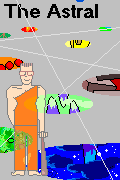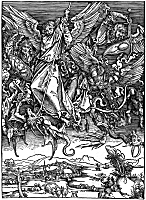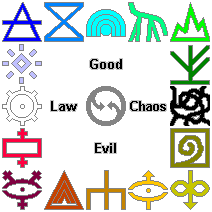

Help yourself to my Planescape Character Generator for MS-DOS.
The astral plane is "the silver void". It is the extended access route to the alignment planes. Just as the elemental planes provide the substance for the natural world, so the astral is a place of potential ideas which provides the substance for the alignment planes, where our ideals and ideologies take physical form. The astral is a dimension of mind -- a bleak, barren expanse of silvery-gray, with a few inhabitants and many gateways into other worlds.
The concept of the "astral plane" comes to AD&D from theosophy and occult lore. According to mystical traditions, the living human body is coextended by a duplicate. The double is supposedly made of starstuff, and hence is called the "astral body".
During trances, the astral body may supposedly separate and carry consciousness into a world of ideas which appears to be extended space. The realm responds to mind, and what the spirit experiences there depends on its attitudes.
During natural life, the astral body is supposed to be attached by a "silver cord" (see the puzzling last chapter of "Ecclesiastes", which otherwise seems to refer to old age). After death, the cord is cut, and life begins (or resumes) in the world of ideas, where consciousness shapes reality and the kind of person you've chosen to be makes all the difference.
Some Christians, including many Anglicans, think that this is what the "intermediate state" may be like, before final, permanent entry into heaven (or final refusal of love, and entry to hell).
Gary Gygax adopted the occult lore of the astral, the underpinnings of the alignment planes, to be the realm of ideas. In "AD&D" as in the traditions about the astral plane, consciousness shapes the world in which you live, and communities are brought together by shared beliefs. AD&D differs from other traditions in having the astral itself remain unmolded by consciousness, and the realms of developed ideas taking the form of the alignment planes.
Gary Gygax's original notes on the astral plane were developed by Roger Moore and then by Jeff Grubb. Later, a "Planescape" book was published on the subject. In the Third Edition, the astral has color-coded (new system) pools to all other planes, both inner and outer. Unlike the Third Edition ethereal and shadow planes, one cannot travel from one point to another on a single plane, or spy on a plane, using the astral, and upon returning, one ends up at or near the original point of departure.
The astral void extends to infinity. It shimmers, evoking infinite possibilities and subtle beauty. "Detect magic" is overwhelmed here by the plane itself. Here and there, adventurers may find the bodies of dead "gods" -- discarded ideals and ideologies, or worse. Land on one of these, and perhaps the adventurers will have strange dreams. The "Athar" sect ("There is at most one god") has its headquarters on one of these corpses.
One or more characters can "plane-shift" or (I would allow) "wind walk" into the astral with all gear, or enter in an unusual form by way of the "astral spell", which seems to be something like a very powerful "projected image". Some clerics, even low-level ones, can send their consciousness into an outer plane by "Astral Journey", though they arrive defenseless and able only to observe and question. Middle-level clerics might be able to cast "Join with Astral Traveller", and join a friend already there. Either way, visitors find themselves in the astral standing by a silvery pool, looking into a reflection of the familiar world. In moments, they are whisked away, perhaps hurtling among images of stars and galaxies beyond numbers.
Time is meaningless here, and all journeys are extremely rapid. The astral is the dimension of undifferentiated ideas that sustains the alignment planes, just as the elemental planes sustain the world of matter. So perhaps it is wrong to talk about "time elapsed until reaching a destination", and to allow all astral journeys to take place immediately, simply determining random encounters.
Here is a possible encounter table for the astral, but it seems likely that one would tend to meet those of similar interests and attitudes. Perhaps the astral would require that creatures encountered have something in common with, or some interest in, the travellers. In a dimension which underpins all higher purposes, things should happen for a reason.
Since the astral is the dimension in which people's interests shape their experiences, then encountered creatures must surely appear in the midst of the party. They would usually have some proposal, often an offer of trade or an offer to join. Evil types may attack. Referees will need to decide whether it is possible to flee at normal movement rate, to flee at infinite speed, or impossible to flee.
 Roll d100 -- and be sure you have numbers and behavior ready.
Roll d100 -- and be sure you have numbers and behavior ready.
1 Astral deva, LG
Movement in a combat situation is (intelligence x 30), in
other words, very fast. Bonuses "to hit" and on damage result
from intelligence, not strength. Defense and missile adjustments
result from wisdom, not dexterity. Missile fire for non-natives
is at -2 because of the unstable footing.
There is no need to breathe or eat on the astral,
and no one can recover
spells on the astral plane.
Here are some methods of access, both official and possible.
In classic AD&D, the astral spell
permitted a group of characters to enter
the outer planes in new bodies. The astral counterparts were
translucent white, bound to the spellcaster(s) by silver cords,
and a similar cord binds the spellcaster(s) to the prime plane.
These bodies can be flesh and blood, or any element that is handy
-- the latter will always offer some advantages and
disadvantages, which can be discussed with the sages' union prior
to making the trip. If killed on the alignment plane, the
adventurers would merely return to their home worlds, and even if
they fail the system shock roll, they will merely go to zero hit
points. Individual or group suicide on the alignment planes is
impossible, and those in charge on the alignment planes usually
forbid a visiting spellcaster to dispel the "astral spell".
The major disadvantage of using the "astral spell" was that a
successful "dispel magic" ends the trip immediately. If the
silver cord is cut (which almost never happens), the character's
bodies would both die. Items carried from the prime plane must be
magic or blessed, and if the astral counterpart of an item is
lost or destroyed, its prime counterpart is disintegrated.
After reading AD&D scenarios for 20 years, I have never seen
the "astral spell" suggested as a preferred means of going on
an adventure. Risk-free travel to other worlds, but with the likelihood
of an abrupt end from "dispel magic", is not the stuff of heroic fantasy.
It would seem best-suited for a short, information-gathering visit.
Color pools were an invention which would seem
to be worth preserving. I have modified the code a bit.
It would seem a shame, in the dimension where ideas become reality,
not to indicate the nature of the pool in some way.
The pools provide entry to the outer planes, and they may be
found by intuition by a cleric or strongly-aligned roleplayer.
It takes (20 - leader's
intelligence) encounter checks to get to a pool of the visitor's
choice, 1 encounter check using "find the path". The alignment
of the pool will be apparent from its color, from some nearby
marker (they are never mismarked), or from using "know
alignment", "identify", "divination", "legend lore", or "true
seeing". Those like-aligned will feel at ease near a color pool,
while those with contrary outlooks will be uncomfortable. The
adventurers' home plane always appears within a silver pool.
Sometimes pools may appear as video screens, grilled gates,
cells, tinted mirrors, etc., etc. They function as usual.
As the points at which the sum of all purposes become limited to particular
points of view, it's unimaginable that the destinations are not
identifiable. Probably everybody sees the pools coded in a way
which is personally meaningful. My suggestions for pool
colors:
The party stands outside the pool, and one member selects
the viewing area. Looking into the pool shows the upside-down
reflection of the other plane (and probably some inhabitants).
If an intelligence check succeeds, the viewer has found the
desired point of entry. Otherwise keep checking, one encounter
check farther away each time.
Roll a random encounter for the new plane as soon as someone
looks into the pool. Creatures on the alignment plane who see
the pool can also see the reflection of the party in the pool
(upside-down, of course). If they like, they can force the party
into the alignment plane at once using "dispel magic" (always
works, and the pool disappears). Or they can reach into the pool
and actually pull the astral intruder out. (Each side rolls d20;
the character making a successful strength check wins; if both
make the check, high roll wins.) A creature on the alignment
plane with higher intelligence than the party leader can dispel
the pool, leaving the party either on the astral or on the
alignment plane at the creature's choice.
Viewing "sets" the pool for one day, and causes the pool to
appear on the alignment plane, or to show the creatures'
reflection if it was already there. On some planes, the leader
can cause the pool to move at a rate of ten yards per point of
intelligence per round. The pool will not move through
substantial living beings (including ivy), metal, certain
mortars, or into most homes. When the party wants to enter the
plane, they merely jump into the pool, and jump out on the plane,
fully combat-ready. The pool remains open and fixed on the plane
for one day, and during this time the party can escape through
it. Only good creatures can pursue them through the pool.
For a randomly-encountered pool, there is a small (DM's
option) chance that it has been opened by a petrifier (medusa,
gorgon, basilisk, cockatrice). Roll "to hit AC 0" for the
petrifier. If this succeeds, everyone looking into the pool must
check vs. constitution or be petrified.
The Third Edition offers an alternative idea about the "astral plane"
which will probably be popular with gamers.
The astral could be the world of the spirits, coextensive with our own world
and duplicating whatever has spiritual significance.
Nature is grander and more beautiful, and the spirits of natural
features can be met here. As long as the ancestors are remembered,
they watch and protect their children from this dimension, perhaps
coexisting on their alignment planes as well.
Gateways to the alignment planes are perhaps located in the
corresponding places of worship. Or the places of worship might
coexist on both planes and some action by the faithful
changes their destination when they leave, or even who else
seems to be present in the building. Gateways to the elemental
planes might be in volcanoes, ocean depths, mountain roots, or the eyes
of hurricanes. I respectfully suggest that the physical aspects of this
plane be exactly as our own world, and that when the living visit, they
be treated as "outsiders".
Gamers for Christ --
news group
2 Astral deva, NG
3 Astral deva, CG
4 Upper planes type, LG
5 Upper planes type, NG
6 Upper planes type, CG
7 Modron patrol
8 High-level party
9 Slaad gang
10 Rakshasa patrol
11 Lower planes types, LE
12 Lower planes types, NE
13 Lower planes types, CE
14-20 Nasty character types ("Nobody understands me!")
21 Thendar
22 Githyanki
23 Mindflayers
24 Adventurers, good-aligned
25 Adventurers, neutral-aligned
26 Adventurers, evil-aligned
27 Corpse -- DM's choice;travels with party
28 Petrified creatures -- DM's choice, travels with party
29 Globe of matter -- DM's choice, travels with party
30 Stray arrow -- roll to hit a random member, THACO 20.
31 Color pool -- DM's choice (party has misteleported)
32 Color pool -- DM's choice; creature emerges
33 Color pool eruption -- many different; each party
member must check vs. dexterity or fall into one (DM's
choice)
34 Salvation Army -- repentance preachers, well-protected, healers
35
Far Skies Clerics
36-00 No encounter
Diamond: Lawful neutral
Sky blue: Lawful, good tendencies
Sapphire: Lawful good
Opal: Good, lawful tendencies
Sea green: Neutral good
Light green: Good, chaotic tendencies
Emerald: Chaotic good
Forest green: Chaotic, good tendencies
Black: Chaotic neutral
Olive drab: Chaotic, evil tendencies
Dirty yellow: Chaotic evil
Ocher drab: Evil, chaotic tendencies
Rusty orange: Neutral evil
Maroon: Evil, lawful tendencies
Dirty red: Lawful evil
Ruby: Lawful, evil tendencies
Gray: True neutral
Home prime: Silver
Other prime: Other metallic
White spiral: Ethereal (ether cyclone)

Acheron -- Lawful, Evil Tendencies
Arborea -- Chaotic Good
Arcadia -- Lawful, Good Tendencies
Baator -- Lawful Evil
The Beastlands -- Good, Chaotic Tendencies
Bytopia -- Good, Lawful Tendencies
Carceri -- Evil, Chaotic Tendencies
Elysium -- Neutral Good
Gehenna -- Evil, Lawful Tendencies
The Gray Waste -- Neutral Evil
Limbo -- Chaotic Neutral
Mechanus -- Lawful Neutral
Mount Celestia -- Lawful Good
The Outlands -- True Neutral
Pandemonium -- Chaotic, Evil Tendencies
Ysgard -- Chaotic, Good Tendencies
The Inner Planes
What "Planescape" could be
AD&D and the Religious Right
Li Po's Hermitage (character generators, more)
Page background by Ed
Fourth Edition
Third edition: DD3.5, d20 Modern, Dragonlance, Eberron, Forgotten Realms, lots more.
AD&D2 Generic Character Generator for MS-DOS.
AD&D2 for very limited machines for MS-DOS.
Alternity Science Fiction Character Generator for MS-DOS.
Birthright Character Generator for MS-DOS.
Dark Sun 2 Character Generator and
documentation for MS-DOS.
Jakandor Character Generator
Lankhmar Character Generator
Planescape Character Generator for MS-DOS.
Psionics Character Generator for MS-DOS.
Red Death Character Generator for MS-DOS.
Skills & Powers Character Generator for MS-DOS.
| New visitors to www.pathguy.com reset Jan. 30, 2005: |
